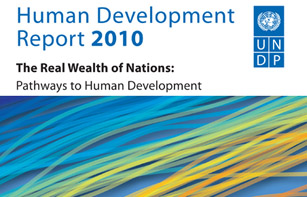A version of this story first appeared at undp.org
Most developing countries made dramatic yet often underestimated progress in health, education and basic living standards in recent decades, with many of the least developed countries posting the greatest gains. This is one of the key findings revealed in the United Nations Development Programme (UNDP) 2010 Human Development Report, released 4 November.
However, despite significant progress in some countries, patterns of achievement vary greatly, with some nations losing ground since 1970, the report shows. The 20th anniversary edition, which introduces three new indices for inequality, gender and poverty, documents wide inequalities within and among countries and deep disparities between women and men on a broad range of development indicators. It highlights the prevalence of extreme multidimensional poverty in South Asia and sub-Saharan Africa and the AIDS epidemic is also shown to have had a marked negative impact on progress in some countries.
The Human Development Reports have changed the way we see the world
UN Secretary General Ban Ki-moon
The report, called The Real Wealth of Nations: Pathways to Human Development, was launched by UN Secretary-General Ban Ki-moon, UNDP Administrator Helen Clark and Nobel laureate Amartya Sen who helped devise the HDI for the first Human Development Report in 1990 with the late economist Mahbub ul Haq, the series founder.
“The Human Development Reports have changed the way we see the world,” Ban Ki-moon said. “We have learned that while economic growth is very important, what ultimately matters is using national income to give all people a chance at a longer, healthier and more productive life.”
According to Helen Clark, “The report shows that people today are healthier, wealthier and better educated than before. While not all trends are positive, there is much that countries can do to improve people’s lives, even in adverse conditions. This requires courageous local leadership as well as the continuing commitment of the international community.”
The report shows that people today are healthier, wealthier and better educated than before.
Helen Clark, DP Administrator
Overall, as shown in the report’s analysis of all countries for which complete HDI data are available for the past 40 decades, life expectancy climbed from 59 years in 1970 to 70 in 2010, school enrolment rose from just 55 percent to 70 percent, and per capita GDP doubled to more than US$ 10,000. Several poorer countries have registered substantial gains in education and public health, including Benin, Cambodia and Ethiopia, which ranked 11th in progress over time.
The region with the fastest HDI progress since 1970 was East Asia, led by China and Indonesia. A number of countries in sub-Saharan Africa and the former Soviet Union lagged behind, however.
“We see great advances, but changes over the past few decades have by no means been wholly positive,” the authors write. “Some countries have suffered serious setbacks, particularly in health, sometimes erasing in a few years the gains accumulated over several decades... And the gaps in human development across the world, while narrowing, remain huge.”



